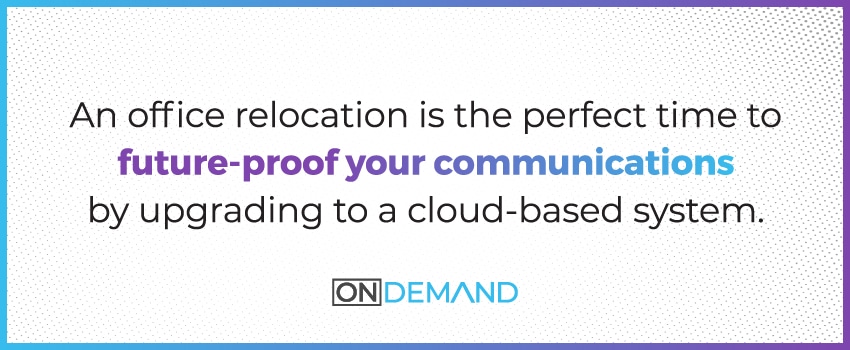Moving your office technology can be a stressful process, filled with potential pitfalls. Without careful planning, you could face unexpected delays, technical issues, and unnecessary costs. Read on for some practical tips to help you avoid these common mistakes and ensure your technology move goes smoothly.
1. Start Planning Early
Early planning is essential when moving office technology. Coordinating with your IT team and vendors from the beginning will help prevent last-minute scrambling. Here are some steps to take when initiating your planning process:
- Get your IT team involved: Let your internal IT team and external technology vendors know about the move well in advance. This gives them the time they need to handle the technical aspects of the relocation.
- Create a timeline: Map out each stage of the move to make sure everything from internet service installation to phone system relocation happens on schedule.
- Conduct an inventory audit: Document your existing equipment, software licenses, and service contracts so that nothing gets overlooked during the move.
Planning early can help you identify potential issues and develop contingency plans to save time and reduce stress during the relocation.
2. Order Your Internet
One of the most common mistakes businesses make when moving office technology is not ordering internet early enough. Depending on the type of internet service you need, it can take 30 to 90 days or more to have it installed. Don’t forget to:
- Plan for delays: Be aware that some services require extensive lead times, especially if you’re switching to fiber internet or need infrastructure upgrades.
- Review your contract: Check your current internet contract for early termination fees or other commitments that might affect your move.
Taking the time to properly plan your internet service transition will help ensure your business stays connected throughout the move process.

3. Use a Move Consultant
Office technology moves can be complicated, but working with a move consultant helps alleviate much of the stress. A move consultant can manage the logistics of your technology relocation and coordinate all the necessary vendors. Here’s what a consultant can do for you:
- Expert coordination: Move consultants handle everything from internet service setup to equipment installation to keep your move on track.
- Vendor management: Consultants can help manage contracts and timelines with third-party vendors, ensuring that nothing is overlooked.
- Risk assessment: A move consultant can find and fix potential issues before they become problems to help you avoid costly mistakes or delays.
- Budget optimization: Consultants leverage their experience to help you find cost-effective solutions and prevent unnecessary expenses during the move.
Ultimately, investing in the right move consultant can save you time, money, and stress during your office technology relocation.
4. Transfer Your Phone System
Your phone system deserves special attention during a move, especially if you’re using an older system. Traditional phone systems have more rigid requirements and dependencies compared to newer VoIP or cloud-based systems. Be sure to:
- Plan for extra time: Legacy phone systems may need more extensive planning and coordination with your provider.
- Consider an upgrade: If your phone system is outdated, consider switching to a cloud-based system during the move to future-proof your communication infrastructure.
Planning your phone system transfer now can help you ensure uninterrupted communication capabilities when you get to your new location.

5. Communicate With Key Stakeholders
When moving office technology, constant communication with your leasing agent, property manager, and other critical vendors will help ensure a smooth transition. Here’s how to keep everyone in the loop:
- Coordinate with your leasing agent: Make sure your leasing agent knows about your technology needs in the new space, such as cabling and power requirements.
- Work with property managers: Property managers can assist in preparing the physical infrastructure, from cabling to security systems, at your new office.
- Schedule regular updates: Set up recurring meetings with all stakeholders to discuss your progress, challenges, and next steps throughout the moving process.
Providing clear and consistent communication throughout the move can help prevent misunderstandings and keep all parties working toward the same goals.
6. Plan for Cabling and Network Infrastructure
Finally, don’t forget to plan for your cabling and network infrastructure in the new location. The layout of your new office space may affect how your network is set up, so it’s important to design a cabling plan that suits your needs. Keep these steps in mind:
- Assess the new layout: Make sure the cabling plan accounts for where equipment, workstations, and other devices will be located.
- Work with professionals: Having professionals install your cabling and network infrastructure can reduce issues that could affect productivity and connectivity.
- Document everything: Keep detailed documentation of your new network setup, including cable runs, network diagrams, and equipment locations.
- Test thoroughly: Conduct comprehensive testing of every network connection and system before your official move-in date.
A well-planned and properly implemented network infrastructure provides the solid foundation your business operations depend on in the new space.
Let OnDemand Help You Move Your Office Technology
Successfully moving office technology requires thorough planning and organization. Following these steps can help you avoid problems and ensure your technology transition goes according to plan – but you don’t have to handle this complex process on your own.
At OnDemand, we’re experienced advisors who can help you make smart technology decisions for your office move. We’ve spent 15 years vetting our supplier partners and building the expertise needed to guide you toward best-fit solutions. We’ll work as an extension of your IT team to handle the tedious tasks of identifying, evaluating, and engaging providers for your technology transition.
Ready for a stress-free office technology move? Contact us today for expert support.
